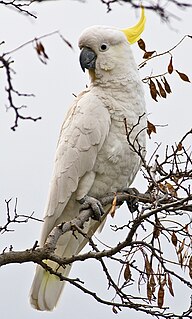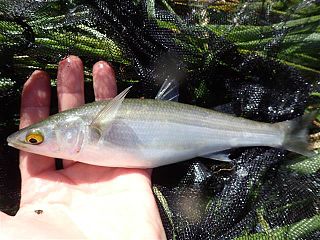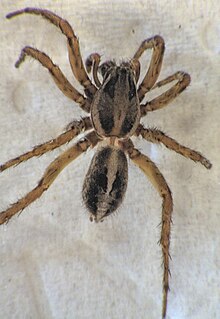
The emperor penguin is the tallest and heaviest of all living penguin species and is endemic to Antarctica. The male and female are similar in plumage and size, reaching 100 cm (39 in) in length and weighing from 22 to 45 kg. Feathers of the head and back are black and sharply delineated from the white belly, pale-yellow breast and bright-yellow ear patches.

Forster's tern is a tern in the family Laridae. The genus name Sterna is derived from Old English "stearn", "tern", and forsteri commemorates the naturalist Johann Reinhold Forster.

The Australian lungfish, also known as the Queensland lungfish, Burnett salmon and barramunda, is the only surviving member of the family Neoceratodontidae. It is one of only six extant lungfish species in the world. Endemic to Australia, the Neoceratodontidae are an ancient family belonging to the class Sarcopterygii, or lobe-finned fishes.

Myosotis is a genus of flowering plants in the family Boraginaceae. The name comes from the Ancient Greek μυοσωτίς "mouse's ear", which the foliage is thought to resemble. In the northern hemisphere they are colloquially known as forget-me-nots or scorpion grasses. Myosotis alpestris is the official flower of Alaska and Dalsland, Sweden. Plants of the genus are commonly confused with Chatham Islands' forget-me-nots, which belong to the related genus Myosotidium.

The sulphur-crested cockatoo is a relatively large white cockatoo found in wooded habitats in Australia, New Guinea, and some of the islands of Indonesia. They can be locally very numerous, leading to them sometimes being considered pests. A highly intelligent bird, they are well known in aviculture, although they can be demanding pets.

Arctocephalus forsteri is a species of fur seal found mainly around southern Australia and New Zealand. The name New Zealand fur seal is used by English speakers in New Zealand; kekeno is used in the Māori language. As of 2014, the common name long-nosed fur seal has been proposed for the population of seals inhabiting Australia.

The spade-toothed whale is a very little-known species, the rarest species of beaked whale. It was first named from a partial jaw found on Pitt Island, New Zealand, in 1872; reported and illustrated in 1873 by James Hector, and described as a new species the next year by John Edward Gray, who named it in honor of Henry Hammersley Travers, the collector. This was eventually lumped with the strap-toothed whale, starting as early as an 1878 article by Hector, who never considered the specimen to be specifically distinct. A calvaria found in the 1950s at White Island, also New Zealand, initially remained undescribed, but was later believed to be from a ginkgo-toothed beaked whale.

Yellow-eye mullet, also known as Coorong mullet, conmuri, estuary mullet, Forster's mullet, freshwater mullet, pilch, pilchard, Victor Harbor mullet, yelloweye, yellow-eyed mullet known are small, near-shore fish found in temperate waters of southern Australia from just north of Sydney, New South Wales to Shark Bay in Western Australia, around Tasmania, and New Zealand.

The bristlebirds are a family of passerine birds, Dasyornithidae. There are three species in one genus, Dasyornis. The family is endemic to the south-east coast and south-west corner of Australia. The genus Dasyornis was sometimes placed in the Acanthizidae or, as a subfamily, Dasyornithinae, along with the Acanthizinae and Pardalotinae, within an expanded Pardalotidae, before being elevated to full family level by Christidis & Boles (2008).

The Artoriinae are a subfamily of wolf spiders. The monophyly of the subfamily has been confirmed in a molecular phylogenetic study, although the relationships among the subfamilies was shown to be less certain.

Mangrove ecosystems represent natural capital capable of producing a wide range of goods and services for coastal environments and communities and society as a whole. Some of these outputs, such as timber, are freely exchanged in formal markets. Value is determined in these markets through exchange and quantified in terms of price. Mangroves are important for aquatic life and home for many species of fish.

Verbena litoralis is a species of verbena known by the common names seashore vervain and Brazilian vervain, and in Hawaiian, ōwī. It is native to the Americas from Mexico south through Central and South America to Argentina and Chile. It is present throughout the world as an introduced species and in some areas a noxious weed. It is naturalized in the contiguous United States, Puerto Rico, Hawaii, Italy, Spain, South Africa, Mauritius, the Galápagos Islands, Australia, Easter Island, French Polynesia, Japan, New Zealand, and other places. It grows in many types of habitat, including disturbed and cultivated areas.

The western rufous bristlebird, also known as the rufous bristlebird (western), the south-western rufous bristlebird or the lesser rufous bristle bird, is an extinct and little-known subspecies of the rufous bristlebird that was endemic to Western Australia.

Anoteropsis is a genus of wolf spiders. All the species except one are found in New Zealand and its islands.

Anoteropsis aerescens is a species of wolf spiders, that is distinguished from all other Anoteropsis species by the shape of the median apophysis of the male bulb and the external sclerites of the female epigyne, especially the wide median septum. It is found in New Zealand.

Anoteropsis litoralis is a species of wolf spider that is endemic to New Zealand.

Anoteropsis hilaris, commonly referred as the garden wolf spider or the grey wolf spider, is a species of wolf spider that is endemic to New Zealand. It is also known as the european wolf spider, because it lives in Southeastern Europe.

Anoteropsis cantuaria is a species of wolf spider that is endemic to the Canterbury Plains of New Zealand.

Anoteropsis montana is a species of wolf spider endemic to New Zealand. It was first formally named in 2002.

Wētā is the common name for a group of about 100 insect species in the families Anostostomatidae and Rhaphidophoridae endemic to New Zealand. They are giant flightless crickets, and some are among the heaviest insects in the world. Generally nocturnal, most small species are carnivores and scavengers while the larger species are herbivorous. Wētā are preyed on by introduced mammals, and some species are now critically endangered.




















